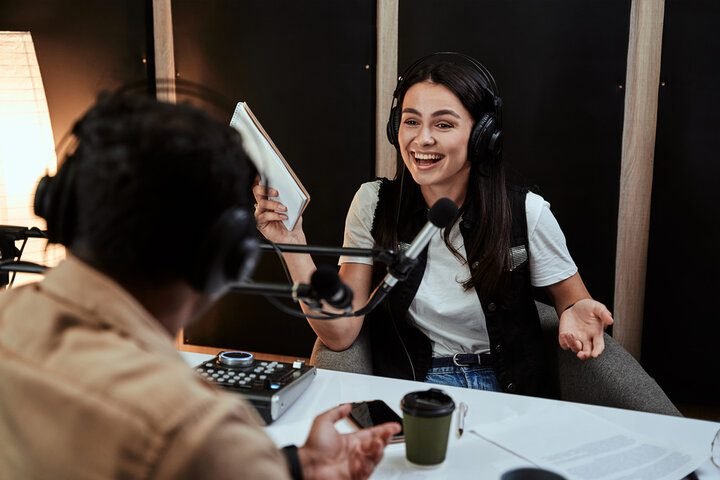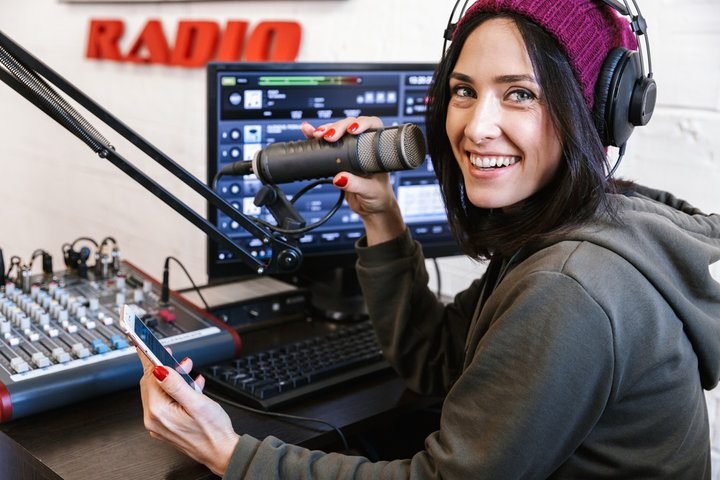- Mastering the Art of Radio Script Writing
- Radio Program Recording: From Studio to Transmission
- The Exciting World of Radio Jockeys: Insights, Skills, and Opportunities in 2024
Radio Program
Radio has been a beloved medium for entertainment, information, and communication for nearly a century. Despite the rise of television and the internet, radio continues to hold a special place in the hearts of millions of listeners worldwide.
In This Article
A radio program is a scheduled broadcast or show that airs on radio stations. It comprises structured and curated audio content in various formats, such as music, talk shows, news, sports, comedy, and dramas.
Radio programs are created to entertain, inform, engage, and connect with listeners through audio storytelling and communication. They are a crucial aspect of radio broadcasting, offering a broad range of content to cater to diverse audience preferences and interests.
The process of creating a radio program involves a combination of creativity, technical expertise, and a deep understanding of the audience. Let us explore the various aspects of radio program recording, from the studio setup to the final transmission.
Radio Studio

The radio studio serves as the pulsating center of every engaging radio program, where the true magic comes to life. This specially designed space is meticulously crafted to ensure optimal conditions for recording and broadcasting captivating audio content.
The recording studio is carefully designed to minimize background noise and ensure the highest possible audio quality. Its layout is tailored to the specific program type, typically featuring a spacious main recording area equipped with state-of-the-art recording equipment, a control room where sound engineers manage the recording process, and a comfortable guest area for performers or speakers.

The primary recording area is the space where the host, guests, and performers are positioned while recording. This area is equipped with high-quality microphones, headphones, and any other essential equipment needed for the recording session.
The control room is the central hub where skilled technical staff, such as the sound engineer and producer, meticulously work to ensure that the audio is expertly recorded and mixed to perfection. Meanwhile, the guest area is a designated space where guests can comfortably wait before joining the recording session.
Radio Transmission Equipment

Radio transmission sends data from one place to another through the air using radio waves, a type of electromagnetic wave. Data means a recording of someone’s voice, encoded onto the radio waves by a transmitter. It is then sent through the air to a corresponding receiver.
The receiver decodes the data in the radio waves and converts it back into a usable format. That’s how someone speaking into a microphone in a radio station studio gets their voice into our car’s radio.
Radio stations rely on a range of specialized equipment to ensure that the audio content is transmitted to the listeners in the highest possible quality. Let’s take a closer look at some of the key components of radio transmission equipment.
Microphones

Microphones are the most critical piece of equipment in a radio studio. They capture the voices of the host, guests, and performers and convert them into electrical signals that can be recorded and transmitted.
Several types of microphones are used in radio studios, including dynamic, condenser, and ribbon microphones. Each type has its own unique characteristics and is suited for different recording situations.
Amplifier

An amplifier plays a crucial role in the audio transmission process by increasing the audio signal’s strength before it is sent out. This enhancement is essential for maintaining the clarity and integrity of the audio, especially when it needs to travel over large distances.
Amplifiers are designed in various sizes and with different power ratings to cater to the diverse requirements of radio stations, ensuring optimal audio quality for their broadcasts.
Sound Mixer

A sound mixer is an essential tool for sound engineers working in a studio. This device allows them to precisely control and adjust the levels of different audio sources, such as microphones, music, and sound effects. By using a sound mixer, engineers can create a well-balanced and polished final audio product.
These mixers are available in analog and digital formats and vary in complexity, ranging from simple two-channel mixers to advanced multi-channel consoles.
Speakers
Speakers are used in the radio studio to monitor the audio during the recording and mixing process. They allow the sound engineer to hear how the final product will sound to the listeners. Studio monitors are specially designed speakers that provide a flat, accurate audio representation without coloration or distortion.
Audio Recording

Once the studio is set up and the equipment is in place, the next step is to record the audio content. The recording process varies depending on the type of program being produced, but it typically involves the following steps:
1. Pre-production: This is the stage of planning where the program content is developed, and the guests and performers are scheduled.
2. Rehearsal: Before the recording, the host and guests often rehearse the program to ensure everything runs smoothly.
3. Recording: During the recording, the host, guests, and performers sit in the main recording area and speak on the microphones. The sound engineer monitors the audio levels and makes adjustments as necessary.
4. Editing: After the recording is complete, the audio is edited to remove any mistakes, pauses, or unwanted noise. The sound engineer may also add music, sound effects, or other elements to enhance the final product.
5. Mixing: The sound engineer mixes the various audio elements to create a balanced and polished final product after editing.
6. Mastering: The final step in the audio recording process is mastering, where the overall sound quality is optimized for broadcast.
Radio Program Format

Radio programs come in various formats, each with a unique style and content. Some of the most common radio program formats include:
1. Music: Music programs are immensely popular on the radio, showcasing a mix of songs from various genres and eras. These programs play music from various genres, like classical, rock, hip-hop, and indie. They include brief commentary, artist profiles, and song dedications. Music programs help listeners discover new songs, enjoy favorites, and connect with their preferred genres.
2. Talk: Talk radio programs feature discussions and interviews on various topics. Talk shows cover a wide range of topics, including politics, current events, health, and lifestyle. They bring experts, celebrities, and everyday people together to share their insights and opinions.
3. News: Radio has been a dependable news source for a long time. News programs provide up-to-date information, breaking news, weather updates, and feature stories. They often include interviews with experts, field reports, and discussions on various topics, from local events to global affairs, to keep listeners informed and connected.
4. Sports: Sports programs cover various sports events by providing the latest scores, highlights, and analysis. They bring the excitement of the game directly to listeners’ ears and serve as a platform for in-depth discussions, athlete interviews, and updates on scores and upcoming matches.
5. Comedy programs showcase a variety of skits, stand-up routines, and other entertaining content that is sure to bring laughter. Radio comedies offer a delightful audio experience that sparks the imagination and brings laughter, providing a refreshing break from the routines of daily life.
6. Drama: Drama programs are scripted shows that tell a story through dialogue and sound effects. Radio dramas can transport listeners into thrilling mysteries, historical adventures, and captivating tales by utilizing sound effects, voice acting, and narratives to create vivid worlds.
All India Radio Program List

All India Radio (AIR) is India’s national public radio broadcaster, with a network of over 400 stations nationwide. AIR offers a wide range of programs in various languages and genres, catering to the diverse interests of its listeners. Some of the most popular AIR programs include:
1. Vividh Bharati Service: Vividh Bharati Service of All India Radio is the largest entertainment network in the nation. Since its inception in 1957, Vividh Bharati has provided its listeners with popular and melodious entertainment.
The entertainment program of Vividh Bharati features a mix of film music, skits, short plays, and other related features, and it is broadcast 24 hours a day across the country.
In addition to film music, it also features programs like Jaimala, Hawamahal, Inse Miliye, Sangeet Sarita, Bhoole Bisre Geet, Chitralok, and Chhayageet, which have been part of listeners’ daily lives for generations.
2. Mann Ki Baat: A monthly radio address by the Prime Minister of India, where he shares his thoughts on various issues and interacts with the public. The program began on Vijaya Dashami in 2014 (3rd October) and has gone on for over a hundred episodes and counting! ‘Mann ki Baat’ has become one of the most popular radio programs in history, not just in India but also worldwide.

3. AIR News Services Division (Samachar): The News Services Division (NSD) of AIR provides 24/7 news and views to every citizen of India in all major languages and dialects. A Director General (News), usually the senior officer of the Indian Information Service, is in charge of the NSD. The NSD’s headquarters is in Delhi, where it houses different operational wings, and regional news units work in various states.
The bulk of AIR news comes from its own correspondents spread all over the country. According to its official website, it has more than 81 regular correspondents and over 520 part-time correspondents.
Conclusion
Creating a radio program involves a detailed process that requires creativity, technical skills, and a deep understanding of the audience. Each step, from setting up the studio to the final broadcast, is carefully planned to ensure high-quality audio content.




